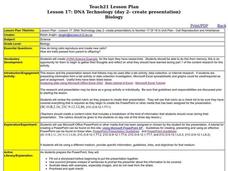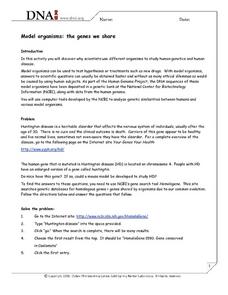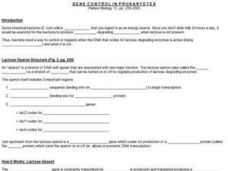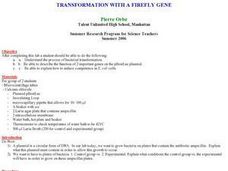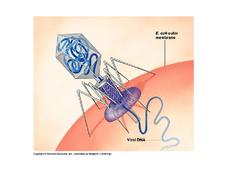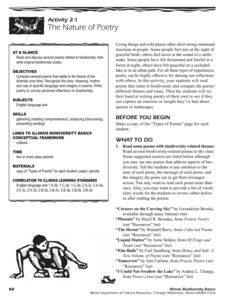Curated OER
RNA and Gene Expression
In this RNA worksheet, students compare and contrast RNA from DNA. Students complete 1 multiple choice and 8 true or false questions.
Curated OER
How Does DNA Determine the Traits of an Organism?
In this DNA worksheet, students examine a sequence of DNA of a fictitious species. They determine the traits the species has given amino acids sequences and chart of traits that each amino acid sequence indicates. Students transcribe and...
Curated OER
Lesson 8: Genetics Problems
Students predict the characteristics of future offspring using punnet squares. For this genetics lesson, students explore monohybrid crosses using an interactive website. They research about causes of blueness in people.
Curated OER
Lesson 14: Genetic Disorders
Students create PowerPoint presentation on the topic they researched. In this biology lesson, students fill out a storyboard about their topic. They share their project in class.
Curated OER
DNA Technology
Young scholars prepare PowerPoint presentation on DNA and cells. In this biology instructional activity, students create a storyboard of their presentation. They share the finished project in class.
Curated OER
What Do Genes Look Like?
Seventh graders describe the basic structure of the DNA molecule. They identify what an inherited trait is and how it can be determined by one or more genes. Finally, 7th graders identify that plant and animal cells contain several...
Curated OER
Model Organisms: The Genes We Share
In this genetics worksheet, students access a website to learn about how human genes mutate to cause heritable disorders such as Huntington disease. Students use the information on this website to complete 12 short answer questions.
Curated OER
Gene Control in Prokaryotes
For this gene control worksheet, students use the example of the lactose operon structure to describe what happens when this structure is absent or mutated. This worksheet has 21 fill in the blank statements.
Curated OER
CONSTRUCTION OF A HEMOGLOBIN GENE
Students use research to see how eight pairs of triplets are equivalent to part of a gene and control a part of heredity. They also understand how red blood corpuscles manufacture normal hemoglobin.
Curated OER
Transformation With A Firefly Gene
Students understand the process of bacterial transformation through experimentation. They describe the function of two important genes of the pBestLuc plasmid. They explain how to induce competence in E. coli cells.
Curated OER
Why do we need Vitamin C in our diet? Or Why do we carry old inactive genes in our genome?
Students explore and explain how mutations in the DNA sequence of a gene may be silent or result in phenotypic change in an organism and in its offspring. They analyze how evolution and biodiversity are the result of genetic changes that...
Curated OER
Breaking News English: Scientists Discover Gene to Waterproof Rice
In this English learning exercise, learners read "Scientists Discover Gene to Waterproof Rice," and then respond to 47 fill in the blank, 7 short answer, 20 matching, and 8 true or false questions about the selection.
Curated OER
Rock, Paper, Scissors
Students explore the concept of dominant and recessive genes by examining the dominant and recessive characteristics of a game of rock, paper, scissors. In small groups students play the game and explain how one move is dominant over...
Curated OER
Genes: The Building Blocks of Life
Pupils examine various topics on genetics. Students explore the Internet to gather information on genetic testing, genetically engineered food, forensics, DNA and cloning. They research and determine the best way to fund each of the...
Curated OER
Inheritance of Genetic Disorders
Students explore inheritance patterns of diseases. In this genetic lesson, students explain how recessive genes may cause human disorders. They identify and research five genetic disorders and present their findings to the class.
Curated OER
AP: Chapter 23: The Evolution of Populations
How and why do populations change over time? AP biology aces explore this question by completing this assignment. They write the answers to 21 questions regarding population genetics, stability, genetic drift, polymorphism, and...
Curated OER
Evolution and Genes
In this psychology worksheet, students complete 5 short answer questions about traits, mutations and the theory of natural selection.
California Academy of Science
Color Vision Genetics Evolution Simulation
At one point, all mammals carried only two color receptors, but now most humans carry three. An informative presentation and hands-on activity demonstrate how this evolved through genetics. By participating in the activity, pupils...
Curated OER
The Nash Case -- Identifying, Choosing and Using Genes
Students complete a variety of exercises as they examine the case of the Nash family who conceived one child in order to provide cells that may be used in a cell transplant for a dying sibling.
Curated OER
Genetics Practice 1: Basic Mendelian Genetics
Six genetics problems are to be solved by junior geneticists. Empty Punnett squares are provided for them to plant the parents' alleles and determine the genotype, phenotype, and frequency of offspring. All of the problems involve actual...
Curated OER
viruses
No title page for this presentation about single-celled processes and gene recombination means that your class would jump into a set of slides full of relevant and detailed information. There are many labelled images and diagrams,...
Curated OER
Lesson: Jazzy Stripes and Worlds
Every artist creates in his own unique way drawing from a variety of inspirational sources. Upper graders work to expand their understanding of the creative process by first analyzing a modern piece and then creating one. They listen to...
Curated OER
Speciation and Genetic Drift Worksheet
Fifteen terms pertaining to speciation, extinction, and gene flow are to be matched to their definitions. This simple, easy-to-read worksheet can be used as a pop quiz for your biology learners when studying natural selection principles...
Illinois Department of Natural Resources
Section Two: Why is Biodiversity Important?
Explore soil, genetic traits, natural resources, and pollution in a series of lessons that focus on biodiversity. Kids complete experiments to learn more about the importance of varied genes and organisms in an ecosystem.
Other popular searches
- Dominant Genes
- Dominant and Recessive Genes
- Recessive Genes
- Genes and Heredity
- Chromosomes and Genes
- Genesis
- Dna, Genes & Chromosomes
- Dominate and Recessive Genes
- Traits and Genes
- Ethnicity Genes
- Color Genes
- Genes Alleles






